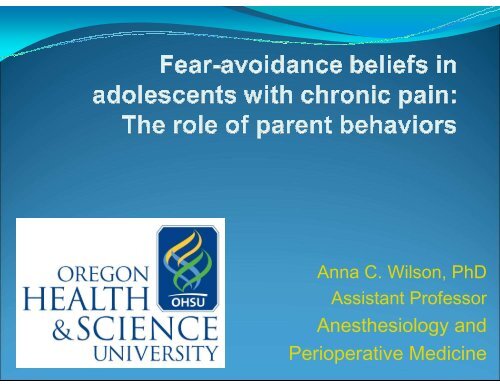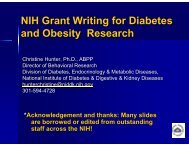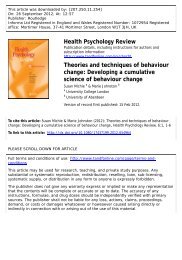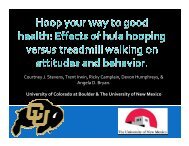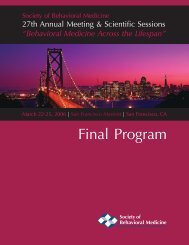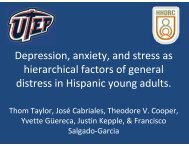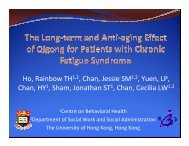Fear-avoidance in adolescence with chronic pain - Society of ...
Fear-avoidance in adolescence with chronic pain - Society of ...
Fear-avoidance in adolescence with chronic pain - Society of ...
You also want an ePaper? Increase the reach of your titles
YUMPU automatically turns print PDFs into web optimized ePapers that Google loves.
Anna C. Wilson, PhD<br />
Assistant Pr<strong>of</strong>essor<br />
Anesthesiology and<br />
Perioperative Medic<strong>in</strong>e
Overview<br />
Background and theory<br />
Chronic pa<strong>in</strong> <strong>in</strong> <strong>adolescence</strong><br />
<strong>Fear</strong>-<strong>avoidance</strong> beliefs <strong>in</strong> <strong>adolescence</strong><br />
Parent factors <strong>in</strong> adolescent <strong>chronic</strong> pa<strong>in</strong><br />
Aims and methods <strong>of</strong> current study<br />
Results and conclusions<br />
Future directions
Chronic and Recurrent Pa<strong>in</strong> is a<br />
Significant Pediatric Health Problem<br />
20-40% <strong>of</strong> children and adolescents <strong>in</strong> community<br />
samples experience persistent pa<strong>in</strong> (Perqu<strong>in</strong> et al., 2000;<br />
Stanford et al., 2008)<br />
More severe persistent pa<strong>in</strong> <strong>in</strong> 8%<br />
Pa<strong>in</strong> accompanied by moderate to severe disability <strong>in</strong><br />
5% (Huguet & Miro, 2008)<br />
Most common locations: head, abdomen, limbs<br />
Multiple pa<strong>in</strong>s are common<br />
More commonly reported <strong>in</strong> girls than boys<br />
Peak <strong>in</strong>cidence: ages 14-15 years (Stanford et al., 2008)<br />
Comorbid anxiety and depression common
<strong>Fear</strong>-<strong>avoidance</strong> beliefs<br />
Cognitions (thoughts and beliefs) about pa<strong>in</strong> be<strong>in</strong>g<br />
l<strong>in</strong>ked to physical activity or movement<br />
“Physical activity makes my pa<strong>in</strong> worse” or “I cannot<br />
do movements that make my pa<strong>in</strong> worse”<br />
<strong>Fear</strong>-<strong>avoidance</strong> beliefs are related to higher levels <strong>of</strong><br />
pa<strong>in</strong> and disability: Well-supported <strong>in</strong> adults <strong>with</strong><br />
<strong>chronic</strong> low back pa<strong>in</strong> (e.g., Jensen et al., 2001; Poiraudeau et<br />
al., 2006)<br />
Few measures <strong>of</strong> fear-<strong>avoidance</strong> beliefs that have<br />
been used <strong>in</strong> children and adolescents
Vlaeyen & L<strong>in</strong>ton, 2000
Cognitions and <strong>avoidance</strong> behaviors develop <strong>with</strong><strong>in</strong><br />
a family context<br />
Parental responses to child pa<strong>in</strong> may <strong>in</strong>fluence<br />
cognitions about pa<strong>in</strong>, <strong>in</strong>clud<strong>in</strong>g fear-<strong>avoidance</strong><br />
Children and parents play a role <strong>in</strong> apprais<strong>in</strong>g or<br />
judg<strong>in</strong>g pa<strong>in</strong> to be more or less threaten<strong>in</strong>g
Parent<br />
behaviors<br />
Vlaeyen & L<strong>in</strong>ton, 2000
Specific parent responses to child pa<strong>in</strong> behaviors<br />
may serve to <strong>in</strong>advertently re<strong>in</strong>force or encourage<br />
pa<strong>in</strong> behaviors<br />
Protective or solicitous responses to child pa<strong>in</strong><br />
associated <strong>with</strong> higher pa<strong>in</strong> <strong>in</strong>tensity and disability<br />
(Claar et al., Pa<strong>in</strong>, 2008; Chambers et al., J Ped Psych, 2002)<br />
Behaviors <strong>in</strong>clude:<br />
Frequent attend<strong>in</strong>g to pa<strong>in</strong> symptoms<br />
Allow<strong>in</strong>g activity <strong>with</strong>drawal from less preferred<br />
activities (e.g., chores, school attendance)<br />
Giv<strong>in</strong>g special privileges or rewards
1. Describe fear-<strong>avoidance</strong> beliefs and correlates <strong>in</strong><br />
a sample <strong>of</strong> adolescents <strong>with</strong> <strong>chronic</strong> pa<strong>in</strong><br />
2. Exam<strong>in</strong>e fear-<strong>avoidance</strong> beliefs and depressive<br />
symptoms as predictors <strong>of</strong> disability<br />
3. Test fear-<strong>avoidance</strong> beliefs as a potential<br />
moderator and mediator <strong>of</strong> parental protectiveness
n = 42 adolescents <strong>with</strong> <strong>chronic</strong> pa<strong>in</strong> (pa<strong>in</strong> 1x/wk or<br />
more, present for >3 months), recruited through<br />
outpatient pediatric specialty care cl<strong>in</strong>ics at a university<br />
children’s hospital (pa<strong>in</strong> cl<strong>in</strong>ic, gastroenterology,<br />
neurology)<br />
Abdom<strong>in</strong>al pa<strong>in</strong> (n = 23)<br />
Headache (n = 11)<br />
Musculoskeletal pa<strong>in</strong> (n = 8)<br />
11-17 years old, Mean age 14.90 (SD = 2.11)<br />
73.8% female<br />
88.1% Caucasian; 7.1% Hispanic;
Pa<strong>in</strong> characteristics<br />
Usual pa<strong>in</strong> <strong>in</strong>tensity, 0-10 NRS<br />
Pa<strong>in</strong> frequency <strong>in</strong> last 3 months<br />
<strong>Fear</strong> and Avoidance Beliefs Questionnaire –<br />
Physical Activity 5-item subscale (FABQ-PA;<br />
Waddell et al., 1993)<br />
Depressive Symptoms: 10-item Major Depressive<br />
Disorder subscale <strong>of</strong> Revised Children’s Anxiety and<br />
Depression Scale (RCADS; Chorpita et al., 2005)
Parental Protectiveness: Adult Responses to<br />
Children’s Symptoms 15-item Protect subscale (Van<br />
Slyke & Walker, 2006)<br />
Item examples: “When your child has aches and<br />
pa<strong>in</strong>s, how <strong>of</strong>ten do you…pay more attention than<br />
usual to your child; give your child special privileges;<br />
br<strong>in</strong>g your child special treats or little gifts”<br />
Physical Activity Limitations: Child Activity<br />
Limitations Interview (CALI; Palermo et al., 2004)<br />
Assesses difficulty do<strong>in</strong>g physical and rout<strong>in</strong>e<br />
activities because <strong>of</strong> pa<strong>in</strong>
Variable<br />
M (SD)<br />
Pa<strong>in</strong> Intensity (0-10) 6.57 (1.74)<br />
Depressive Symptoms 55.98 (13.50)<br />
Disability (CALI):<br />
Adolescent Report<br />
Disability (CALI):<br />
Parent report<br />
19.86 (6.19)<br />
21.05 (6.09)<br />
Parental Protectiveness 1.79 (.51)
Adolescents reported moderate levels <strong>of</strong> fear<strong>avoidance</strong><br />
(FABQ-PA, M = 11.52)<br />
Slightly lower than samples <strong>of</strong> adults <strong>with</strong> <strong>chronic</strong> low<br />
back pa<strong>in</strong> (FABQ-PA, M = 14.0-14.2)<br />
FABQ-PA had slightly low <strong>in</strong>ternal consistency:<br />
Chronbach’s alpha = .69
As hypothesized, the FABQ-PA was significantly<br />
correlated <strong>with</strong>:<br />
Parent-report disability (r = .42, p < .01)<br />
Child-report disability (r = .44, p < .01)<br />
Parental protectiveness (r = .47, p < .01)<br />
FABQ-PA was not related to:<br />
Depressive symptoms<br />
Usual pa<strong>in</strong> <strong>in</strong>tensity<br />
Pa<strong>in</strong> location
CALI: Child report CALI: Parent report<br />
∆R 2<br />
β at f<strong>in</strong>al<br />
step ∆R 2 β at f<strong>in</strong>al<br />
step<br />
Step 1:<br />
.38***<br />
.08<br />
Household Income<br />
Usual Pa<strong>in</strong> Intensity<br />
-.23<br />
.47***<br />
.09<br />
.23<br />
Step 2:<br />
.00<br />
.02<br />
Depressive Symptoms<br />
-.03<br />
.05<br />
Step 3:<br />
.16**<br />
.17**<br />
<strong>Fear</strong>-<strong>avoidance</strong> Beliefs<br />
.42**<br />
43**<br />
Total R 2 : .54*** .27*<br />
* p < .05, ** p < .01, *** p < .001
Tested two models: fear-<strong>avoidance</strong> as a moderator<br />
and as a mediator<br />
<strong>Fear</strong>-Avoidance<br />
Beliefs<br />
Parental<br />
Protectiveness<br />
Child Activity<br />
Limitations
Tested two models: fear-<strong>avoidance</strong> as a moderator<br />
and as a mediator<br />
<strong>Fear</strong>-Avoidance<br />
Beliefs<br />
Parental<br />
Protectiveness<br />
Child Activity<br />
Limitations
Tested two models: fear-<strong>avoidance</strong> as a moderator<br />
and as a mediator<br />
<strong>Fear</strong>-Avoidance<br />
Beliefs<br />
Parental<br />
Protectiveness<br />
Child Activity<br />
Limitations
Results: No support found for moderation model<br />
The association between protectiveness and activity<br />
limitations is not altered by child fear-<strong>avoidance</strong><br />
<strong>Fear</strong>-Avoidance<br />
Beliefs<br />
n.s.<br />
Parental<br />
Protectiveness<br />
.29*<br />
Child Activity<br />
Limitations
Support for mediation model (Sobel z = 1.97, p = .05)<br />
<strong>Fear</strong>-<strong>avoidance</strong> beliefs may serve as one pathway<br />
through which parental protectiveness <strong>in</strong>fluences<br />
activity limitations.<br />
<strong>Fear</strong>-Avoidance<br />
Beliefs<br />
.51** .42*/.40*<br />
Parental<br />
Protectiveness<br />
.29*/.05<br />
Child Activity<br />
Limitations:<br />
Adol. report
As <strong>in</strong> adult <strong>chronic</strong> pa<strong>in</strong> populations, fear-<strong>avoidance</strong><br />
beliefs play an important role <strong>in</strong> adolescent disability<br />
<strong>Fear</strong>-<strong>avoidance</strong> beliefs seem to be important for<br />
adolescents <strong>with</strong> a variety <strong>of</strong> pa<strong>in</strong> problems<br />
<strong>Fear</strong>-<strong>avoidance</strong> beliefs may be less tied to<br />
depressive symptoms and pa<strong>in</strong> <strong>in</strong>tensity <strong>in</strong><br />
adolescents than <strong>in</strong> adults<br />
Parental behaviors <strong>in</strong> response to adolescent pa<strong>in</strong><br />
may <strong>in</strong>fluence adolescent cognitions and fears which<br />
<strong>in</strong> turn <strong>in</strong>crease activity limitations
Strengths:<br />
Associations demonstrated across reporters<br />
(adolescent and parent)<br />
<strong>Fear</strong>-<strong>avoidance</strong> beliefs exam<strong>in</strong>ed <strong>in</strong> a mixed pa<strong>in</strong><br />
problem sample (not only back or<br />
musculoskeletal pa<strong>in</strong>)<br />
Limitations:<br />
Cross-sectional study limits our ability to draw<br />
conclusions about the direction <strong>of</strong> these effects<br />
Relatively small sample limited power to detect<br />
moderation<br />
Did not exam<strong>in</strong>e anxiety symptoms
Exam<strong>in</strong>e role <strong>of</strong> parental behaviors and cognitions <strong>in</strong><br />
shap<strong>in</strong>g adolescent cognitions over time<br />
Exam<strong>in</strong>e additional parental behaviors and beliefs:<br />
Parent catastrophiz<strong>in</strong>g about their child’s pa<strong>in</strong><br />
Parent model<strong>in</strong>g <strong>of</strong> pa<strong>in</strong> behaviors<br />
Enhance understand<strong>in</strong>g <strong>of</strong> how adolescent fear<strong>avoidance</strong><br />
beliefs relate to other pa<strong>in</strong>-related<br />
cognitions such as catastrophiz<strong>in</strong>g<br />
Both parent behaviors and adolescent fear<strong>avoidance</strong><br />
cognitions may be potential <strong>in</strong>tervention<br />
targets
Pediatric Health Pilot Project (PI: Wilson): Oregon<br />
Cl<strong>in</strong>ical and Translational Research Institute (OCTRI),<br />
grant # UL1 RR024140 from the National Center for<br />
Research Resources (NCRR), a component <strong>of</strong> the<br />
National Institutes <strong>of</strong> Health (NIH), and NIH Roadmap for<br />
Medical Research<br />
Colleagues and collaborators:<br />
Tonya Palermo, PhD<br />
Amy Lewandowski, PhD<br />
Caitl<strong>in</strong> Murray, BA


